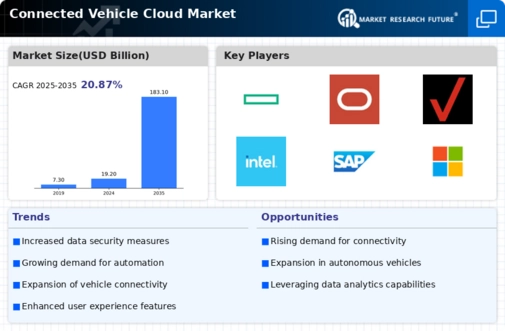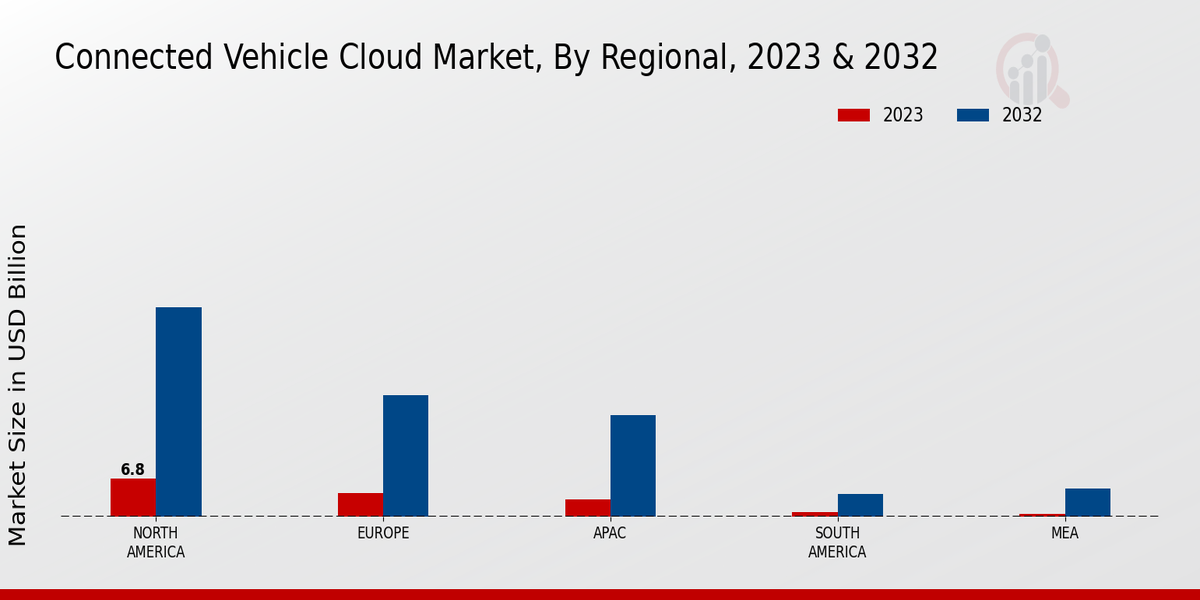Market Growth Projections
The Global Connected Vehicle Cloud Market Industry is poised for substantial growth, with projections indicating a market value of 183.1 USD Billion by 2035. This anticipated growth is underpinned by a compound annual growth rate (CAGR) of 22.74% from 2025 to 2035. Such figures suggest a robust expansion trajectory, driven by factors such as increased vehicle connectivity, advancements in technology, and evolving consumer preferences. The market's evolution is likely to create new opportunities for stakeholders, including automakers, technology providers, and service operators, as they adapt to the changing landscape of connected vehicle solutions.
Advancements in IoT Technology
The Global Connected Vehicle Cloud Market Industry is significantly influenced by advancements in Internet of Things (IoT) technology. The proliferation of IoT devices enables vehicles to communicate with each other and their surroundings, enhancing safety and efficiency. For instance, vehicle-to-vehicle communication can reduce accidents and improve traffic flow. As IoT technology continues to evolve, it is expected to contribute to the market's growth, with a projected CAGR of 22.74% from 2025 to 2035. This growth indicates a robust future for connected vehicle solutions, as automakers leverage IoT capabilities to offer innovative services and improve overall vehicle performance.
Growing Focus on Autonomous Vehicles
The Global Connected Vehicle Cloud Market Industry is closely linked to the growing focus on autonomous vehicles. As manufacturers invest heavily in developing self-driving technology, the need for robust cloud infrastructure becomes apparent. Autonomous vehicles rely on real-time data processing and communication with cloud systems to navigate safely and efficiently. This trend is expected to propel the market towards a valuation of 183.1 USD Billion by 2035. The integration of connected vehicle cloud solutions is critical for the successful deployment of autonomous vehicles, as it enables them to make informed decisions based on real-time information.
Government Regulations and Initiatives
The Global Connected Vehicle Cloud Market Industry is shaped by government regulations and initiatives aimed at enhancing road safety and reducing emissions. Various governments worldwide are implementing policies that encourage the adoption of connected vehicle technologies. For example, regulations mandating vehicle-to-everything communication are becoming more prevalent, driving automakers to invest in cloud-based solutions. These initiatives not only promote safety but also support environmental goals by facilitating more efficient driving patterns. As a result, the market is likely to expand as compliance with these regulations becomes essential for manufacturers seeking to remain competitive.
Increasing Demand for Vehicle Connectivity
The Global Connected Vehicle Cloud Market Industry experiences a surge in demand for enhanced vehicle connectivity. As consumers increasingly seek advanced features such as real-time navigation, remote diagnostics, and over-the-air updates, automakers are compelled to integrate cloud solutions into their vehicles. This trend is evidenced by the projected market value of 19.2 USD Billion in 2024, reflecting a growing consumer appetite for connected services. The integration of cloud technology facilitates seamless communication between vehicles and infrastructure, thereby enhancing user experience and safety. Consequently, this driver is pivotal in shaping the future of the automotive landscape.
Rising Consumer Expectations for Safety and Convenience
The Global Connected Vehicle Cloud Market Industry is driven by rising consumer expectations for safety and convenience features in vehicles. Modern consumers increasingly prioritize advanced safety systems, such as collision avoidance and adaptive cruise control, which often rely on cloud connectivity. This demand is reflected in the growing market size, projected to reach 19.2 USD Billion in 2024. As automakers respond to these expectations by integrating connected technologies, they enhance the overall driving experience. Consequently, this driver is instrumental in shaping product offerings and influencing the competitive landscape within the automotive sector.














